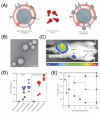Nanomedicine in the Management of Microbial Infection - Overview and Perspectives
- PMID: 25267927
- PMCID: PMC4175422
- DOI: 10.1016/j.nantod.2014.06.003
Nanomedicine in the Management of Microbial Infection - Overview and Perspectives
Abstract
For more than 2 billion years, microbes have reigned on our planet, evolving or outlasting many obstacles they have encountered. In the 20th century, this trend took a dramatic turn with the introduction of antibiotics and vaccines. Nevertheless, since then, microbes have progressively eroded the effectiveness of previously successful antibiotics by developing resistance, and many infections have eluded conventional vaccine design approaches. Moreover, the emergence of resistant and more virulent strains of bacteria has outpaced the development of new antibiotics over the last few decades. These trends have had major economic and health impacts at all levels of the socioeconomic spectrum - we need breakthrough innovations that could effectively manage microbial infections and deliver solutions that stand the test of time. The application of nanotechnologies to medicine, or nanomedicine, which has already demonstrated its tremendous impact on the pharmaceutical and biotechnology industries, is rapidly becoming a major driving force behind ongoing changes in the antimicrobial field. Here we provide an overview on the current progress of nanomedicine in the management of microbial infection, including diagnosis, antimicrobial therapy, drug delivery, medical devices, and vaccines, as well as perspectives on the opportunities and challenges in antimicrobial nanomedicine.
Keywords: Diagnosis; Drug delivery; Medical device; Microbial infection; Nanomedicine; Therapy; Vaccine.
Figures










References
-
- Cohen ML. Nature. 2000;406:762–767. - PubMed
-
- Armstrong GL, Conn LA, Pinner RW. JAMA. 1999;281:61–66. - PubMed
-
- World Health Organization . The Evolving Threat of Antimicrobial Resistance: Options for Action. WHO Press; Geneva: 2012.
-
- Kåhrström CT. Nat. Rev. Microbiol. 2013;11:146. - PubMed
-
- Alekshun MN, Levy SB. Cell. 2007;128:1037–1050. - PubMed
Grants and funding
LinkOut - more resources
Full Text Sources
Other Literature Sources
